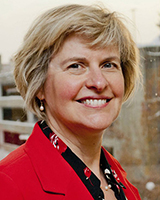Message from Norman Rosenblum, INMD Scientific Director
February 2021

Women and girls comprise half of the global population; however, they are disproportionately underrepresented in research and STEM-related fields. According to The United Nations Educational, Scientific and Cultural Organization (UNESCO) data, female students only make up about 35% of all students pursuing higher education in STEM-related fields (Bokova, 2017). Similarly, women make up less than 30% of all researchers worldwide (UNESCO Institute for Statistics, 2019). In order to achieve gender equality and empower women and girls to pursue science, the United Nations have declared February 11th as the International Day of Women and Girls in Science. To mark this day, Dr. Catherine Field (University of Alberta), a leading nutrition researcher in Canada and Tier 1 Canada Research Chair in Human Nutrition and Metabolism, and Vice-Chair of the INMD Institute Advisory Board, will share her reflections on the progress that has been made to date for women in science, particularly in the INMD mandate areas, and the ongoing challenges that still need to be addressed.
Reflections on Women and Girls in Science
Catherine Field, Professor, University of Alberta
INMD Institute Advisory Board Vice-Chair

In my 30 years in academia, the number of women researchers has increased exponentially.Women were always part of postgraduate studies, but now I see many women going on to careers in research, government, and industry where they will inspire girls to enter the science field.Today’s women scientists are amazing role models to others and are able to balance the demands of their career with their families.
Although we have come a long way, there is still a way to go.In a recent analysis of the Power Gap published in the Globe and Mail (Doolittle R. and Wang C., Jan. 21, 2021) based on data from 82 universities across Canada, universities were found to have among the worst track record on gender representation with women in leadership roles working at universities being outnumbered and out-earned. The story highlights the way that women’s numbers visibly drop off on the way to the top. The Globe and Mail found that in the lowest salary band, women represent just shy of half of all the employees, but by the top 10 percentile of earners, they’re outnumbered three to one. The Globe’s data also showed that women are concentrated in lower-level academic positions. My personal experience backs this up – I see many of our trainees who view the older generation of women in academia - which includes me - as negative role models because they feel that there is not enough balance between their roles outside the University and their roles as researchers.
How do we address this power gap? It is heartening to see that researchers now take a CIHR module on sex and gender and need to address this in their grants.I have observed that universities are only just starting to understand what unprotected ‘parental’ leave does to ‘productivity’ and the lifetime career salaries to women.Now they have to develop institutional policies to better support women in balancing these roles.
The fact that we still have to include women as part of Equity, Diversity and Inclusion (EDI) considerations when hiring continues to surprise me, as women are academically equal as researchers and teachers and should be considered as equals. We have come a long way, but there is still further to go.
References
- Bokova, I. (2017). Cracking the code girls’ andwomen’s education in science, technology, engineering and mathematics (STEM).UNESCO.
- Doolittle, R., & Wang, C. (2021, January 21). Explore the Power Gapin Canadian Universities. The Globe and Mail.
- UNESCO Institute for Statistics (UIS). (2019). Women in Science: Fact Sheet No. 55 [ PDF (467 KB) - external link ].
- Date modified: